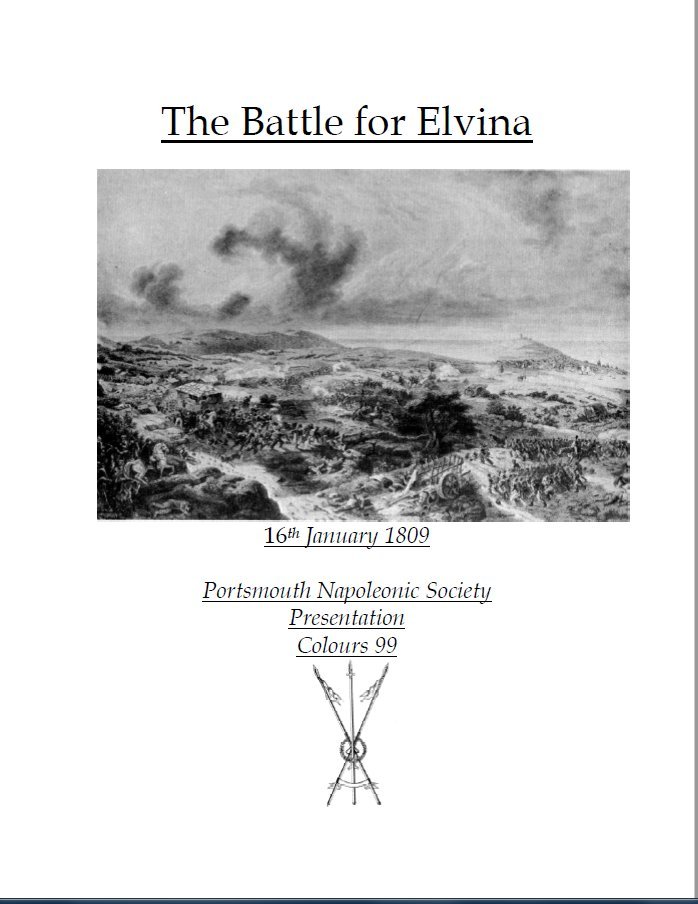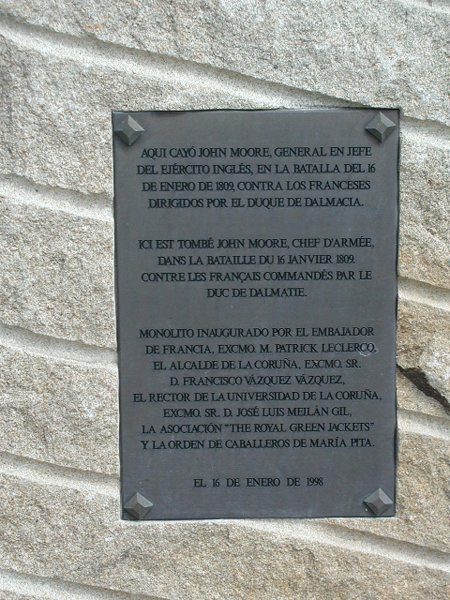The Battle for Elvina
16th January 1809:

The following text was used at Colours
in 1999 and describes the
battle, in accordance with Fortescue’s excellent work. The game that year dealt
solely with the exploits of Maj Charles Napier who is buried in Portsmouth in
and around the village of Elvina.

CORUNNA
16th
JANUARY 1809
0600hrs:
A mist covers the battlefield, but soon clears (by 0900hrs at the latest) to
a bright sunny day, making all positions clearly visible.

Sir John
Moore
0630hrs:
Sir John Moore rides to Monte Mero to inspect the British lines.
1000hrs:
By this time Moore had returned to the town of Corunna. Moore has little
idea whether the French are going to attack or not. He decides to recommence the
embarkation of the army by ordering Fraser and Edward Paget's Divisions
to the rear making ready for others to follow shortly after. Paget positions his
Division at Oza whilst Fraser settles further to the west with the intention of
embarking in the early afternoon.
1200hrs:
Moore recieves a report from General Hope that the enemy lines are mustering
and getting under arms. Moore sets out for Monte Mero to check on the position
himself.


Maps showing
the positions on the 16th January 1809
1215hrs:
First sound of French cannon fire. The 12Pdr Battery dominated the area
opposite the village of Elvina and caused havoc and confusion amongst the
British lines for most of the day. George Napier, Moore’s senior A.D.C. remarks
that Sir David Baird was wounded by almost the first shot fired. Other
authorities suggest later, in fact not long before Moore recievied his fatal
wound (around l600hrs). It would be best to play this element of chance by using
a percentage dice. Baird was taken on board ship where an arm had to be
amputated. Paget had received orders to march to
Corunna Bay but upon the sound of cannon fire Paget instantly retraced his steps
back to Oza to await further orders.
1245hrs:
600 or so French Legre descend from the heights of Penasquedo, and form a
skirmish line forcing the British advanced piquets to slowly withdraw.
The days action at Piedralonga and Palavea Abaxo is much slower than the
rest of the battlefield. Firstly, Delaborde pushes
through Palavea clearing any British piquets. Once accomplished, this Division waits on the Northern edge of the village and in the
early part of the afternoon make diversionary attacks only on Piedralonga.
Carry out this play until the game bound guidelines direct otherwise.
Piquets of the 14th and 92nd British Regiments (one company from each), at
present occupy Piedralonga.
1300hrs:
The majority of Mermets columns descend the slopes, some of La Houssaye’s
cavalry advance towards the lower slopes of San Cristobel. The restricted
terrain slows their movement considerably. In fact the battlefield of Corunna
was entirely unsuited to cavalry and prevents all mounted troops from charging
throughout the whole day.
1315hrs:
Moore sends a message to Fraser to take up position covering the western
coastal road into Corunna. He also orders Paget to move westward towards San
Cristobel covering the extreme British right, further down the Monelos River.
(see map of dispositions). The 95th extend in open
order and soon encounter the forward squadrons of La Houssaye’s Dragoons. The
Dragoons dismount at intervals to fire on Paget's advancing troops.
1330hrs:
Mermet’s 31st Legre advance into Elvina and drive the light company of
the 59th out. The 47th Legre of Mermet’s Division begin to advance in a wide arc
hoping to flank Elvina by the west.
1345hrs:
Piquets from the 50th and 4th Regiments begin to retire from Elvina.
French Voltiguiers under General Jardon begin to harass the British in that
quarter. The British behind Elvina become engaged in firing with the French
forward skirmishers.

Panorama of
Corruna from Mont Mero 1992 the actual battlefield would have been on the right
of this picture (click on picture for larger version)

Pictures taken
on our 2000 trip from the same view point (click on picture to be taken to larger image)

1400hrs:
Charles Napier orders the Grenadier company of the 50th into Elvina. Further
to the right, the French dragoons are making no progress. Although, Paget's main
body of troops are still some distance away from the enemy, the 95th regiment
formed in extended order, were still in contact with La Houssaye’s cavalry who,
by now, were starting to fall back.
1415hrs:
The 47th Legre swing into the British right. The 4th regiment is compelled
to deploy half its battalion at right angles to face this new attack. This
incident happens when the two opposing forces are approximately 100 yards apart.
Sir Robert Ker Porter who accompanied Sir John throughout the campaign wrote on
the 19th of January upon the advance of the French column pressing hard against
the right:
"The numbers of the enemy augmented
their own consternation; they fell back on each other, making a confusion as
successful as our arms"
l43Ohrs:
The French 31st Legre push through Elvina and split their forces into two.
The right hand column (left from the British perspective) advances towards the
42nd Regiment (Black Watch), halts and deploys into two lines.
There are many occurrences in the Peninsular War where the French
infantry seemed to be caught whilst deploying from column of march to a battle
line. The battle of Corunna is no exception. (Troops should be deemed
temporarily unformed if fired upon in this situation). The 42nd Highlanders fire and charge. The 31st Legre give ground momentarily but
both units hold their ground and a fierce skirmish ensues half way up the
slope, North of Elvina. The 52nd Regiment from Pagets
Division' advance into the flank of the 47th Legre. This causes the whole column
to stop in its tracks and now has to deal with both the 4th and 52nd Regiments.
The 50th Regiment have been given no orders, and this perturbs their
commander Charles Napier, who decides to lower the colours because they are
becoming targets for the main l2pdr battery on the ridge.

View from
Penasquedo Heights
taken in 2000 (Click on picture for larger image)
1445hrs:
The 31st Legre steadily fall into and around the confines of the village.
The 42nd take cover near the northern perimeter of Elvina. Napier sees that the
42nd have taken cover among the enclosures and personally orders the advance.
After passing the 42nd the 50th Regt pause at a low
wall to exchange fire and then proceeds into Elvina with some of the 42nd
following in support.
1500hrs:
The 50th halt at some rocks close to the church Napier moves up the South
Western lane with 3 officers and 30 men. They reach a breastwork of stones
previously made by piquets of the 4th. As the French advance to retake Elvina,
Napier finds himself in an isolated position much further forward than
considered prudent. For a moment Napier’s men come within 300yds of the main
French battery situated on the crest of the hill. Its about this time that the
French column who pass by Baird's right were flushed with the idea that they had
turned the British right but as they advance they are met with all of Paget's
Division coming on, the French falter and begin to fall back. La Houssaye’s
cavalry retire and dismount to fire on the advancing troops.
1515hrs:
Mermet’s Division move through Elvina once more. The 50th begin to break and
the 42nd are badly mauled. The French having taken the village again start to
ascend the opposite slope for a second time, with obvious caution.
1530hrs:
Moore now decides to bring up the Brigade of Guards for another assault
before the French can fully recover from their last ordeal. He sends Hardinge
with a request to Warde to "fetch them up immediately”. While waiting for their
arrival, Moore rides over to the West to see what he can discover of Paget's
measures to check the advance of La Houssaye’s cavalry and Mermets five
Battalions on the extreme right. (The 47th Legre has only four Battalions the
other one must be either the Swiss or one Battalion of the 122nd Ligne).
Paget has begun to force the 47th Legre and La Houssaye’s cavalry back.
From now till around 1700hrs Paget will continue to advance up the Penasquedo
Heights (see map) forcing the enemy back until they eventually return to their
original positions behind the crest. Blakeney of the 28th says that had Fraser
been in support, then a chance of charging the l2pdr Battery on the crest could
have been perfectly feasible.

Panorama of
Elvina from the Church (Click on image for larger picture)
1545hrs:
One Battalion of the Guards support the 42nd who are nearly out of
ammunition. The 42nd think they are being relieved by the Guards and begin to
fall back. Moore sees the 42nd withdraw and rides down to say
"My brave 42nd, if you've fired
your ammo, you've still your bayonets. Remember Egypt"
The Highlanders turn back to face the
enemy once more.

The Church in
Elvina



Plaques in
Elvina



1600hrs:
Foy's Voltiguiers swoop out of Palavea Abaxo and drive out the piquets of
Colonel Nicholls 14th Regiment from Piedralonga. Lord Hill reacts by ordering
the main body of the 14th into the village supported by two companys of the
92nd. These attacks last for about an hour. Moore's
Mortal wound is received around this time (l600hrs to l630hrs) and command of
the Army now rests with Sir John Hope.
1615hrs:
Mermet’s reserves now pour down towards Elvina. Reynauds Brigade from
Merle's Division approach Elvina from the East side.

Soult's
Monument to Sir John Moore




1630hrs:
Manningham sends forward the 3rd Battalion 1st
Regiment and The 2nd Battalion 81st Regiment. Hope then sends forward the 2nd
Battalion 59th Regiment of Leith's Brigade to support the attack.
1645hrs:
As darkness begins to fall the French centre begins to retire.
1700hrs:
The British attacks on Piedralonga eventually force Foy out to the
Southern edge of the village. Delaborde orders another Battalion to support, By the close of battle darkness had set in and the British
held the North end of the village whilst the French the Southern end.
1800hrs:
Close of the battle according to Porter was l800hrs:
"The sound of the Artillery and rattling of small arms were heard no more"
ORDER OF BATTLE
The
order of battle shown deals solely with the contending forces around the village
of Elvina.
French: C.I.C. Le Marechal ‘Nicolas’ Jean-de-Dieu Soult, Duc de Dalmatie.
2nd
Division – Gen. De Div. Baron Mermet.
Brigade Gaulois:
31st
Leger (4 btns)
3rd Swiss (I btn)
2 Cies.
Artillery a
Pied. 10 x 12pdr guns.
The
following units had a part to play in the action around the village latter on in
the day.
Brigade Lefebvre :
47th
ligne (4 btns)
Brigade Sarrut: (From Merle’s Division).
4th
Leger (4 btns)
British: C.I.C. Sir John Moore.
1st
Division – Lt-Gen.Sir David Baird.
Bentinck’s brigade:
1/4th
Foot. (Lt Col Wynch)
1/50th
Foot. (Maj C.
Napier)
1/42nd
Black watch. (Lt Col Stirling)
The
following units had a part play in the action.
Warde’s brigade:
1/1st
Foot
Guards
2/1st
Foot
Guards
Known
Casualties:
31st
Leger suffered 330 men. Killed, wounded or taken.
1/50th
Foot suffered 185 men.
1/42nd
Black Watch suffered 146 men.


The El Burgo Bridge in 1992 and 2002
For
more Corunna Pictures click below:

First published by
Portsmouth Napoleonic Society
Sept 1999
The Portsmouth Napoleonic Society
'Over The Hills and Far Away'

